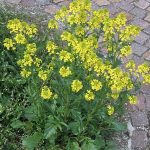 Native to areas of northern Africa, Europe, and Asia, this winter annual is a member of the cabbage family, Brassicaceae, that also includes broccoli, alyssum, and stock. It grows 4-8′ tall and has a dull gray branchless stem and 10″ long stalked leaves that are obovate and lobed below, and elliptic or lanceolate above. The upper surface of the leaves has scattered stiff, short, white hairs while the lower side is smooth except along the midrib. Two inch long racemes of yellow flowers appear in summer for a long bloom time. The flowers are each 1/3″ long, have 4-5 petals, and give way to a narrow seedpod 2/3″ long. Black mustard grows quickly, selfseeds, and produces allelopathic chemicals that inhibit the germination of other plants. It can become invasive especially in grasslands and can increase the spread of fire in broad-leaf shrublands. Leaves, seeds, and stems are edible and the seeds are used to prepare hot mustard. The genus name, Brassica, is the classical Latin name for cabbage. The specific epithet, nigra, is the Latin word meaning black and refers to the color of the seeds.
Native to areas of northern Africa, Europe, and Asia, this winter annual is a member of the cabbage family, Brassicaceae, that also includes broccoli, alyssum, and stock. It grows 4-8′ tall and has a dull gray branchless stem and 10″ long stalked leaves that are obovate and lobed below, and elliptic or lanceolate above. The upper surface of the leaves has scattered stiff, short, white hairs while the lower side is smooth except along the midrib. Two inch long racemes of yellow flowers appear in summer for a long bloom time. The flowers are each 1/3″ long, have 4-5 petals, and give way to a narrow seedpod 2/3″ long. Black mustard grows quickly, selfseeds, and produces allelopathic chemicals that inhibit the germination of other plants. It can become invasive especially in grasslands and can increase the spread of fire in broad-leaf shrublands. Leaves, seeds, and stems are edible and the seeds are used to prepare hot mustard. The genus name, Brassica, is the classical Latin name for cabbage. The specific epithet, nigra, is the Latin word meaning black and refers to the color of the seeds.
Type: Winter annual
Bloom: Racemes of small yellow flowers in summer
Size: 4-8′ H
Light:Full sun to partial shade
Soil: Average, medium moist, well-drained
Hardiness: Not relevant
Care: Remove flowers before seed set to reduce self seeding
Pests and Diseases:Aphids, cabbage worm, flea bettles
Propagation: Seed
Photo Credit: Wikipedia